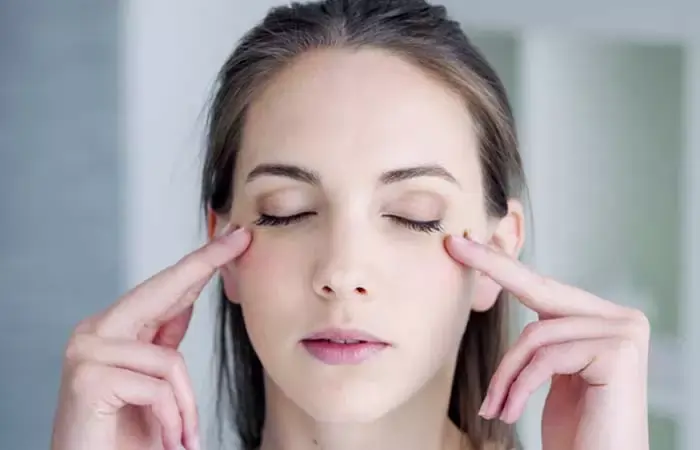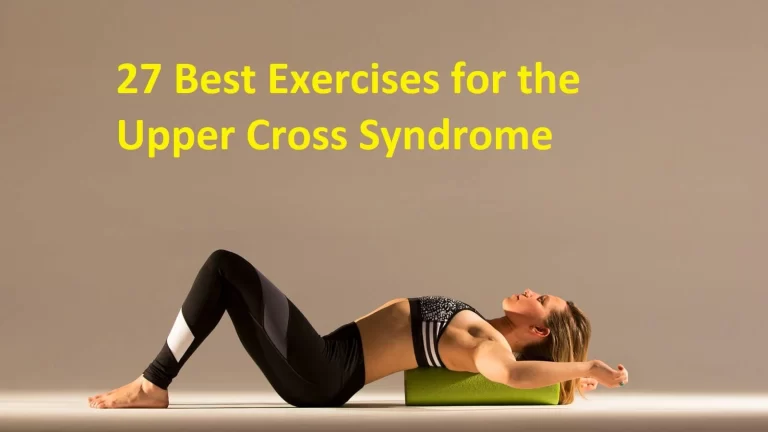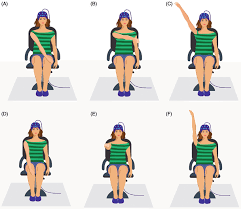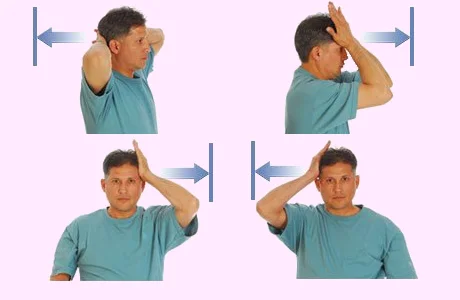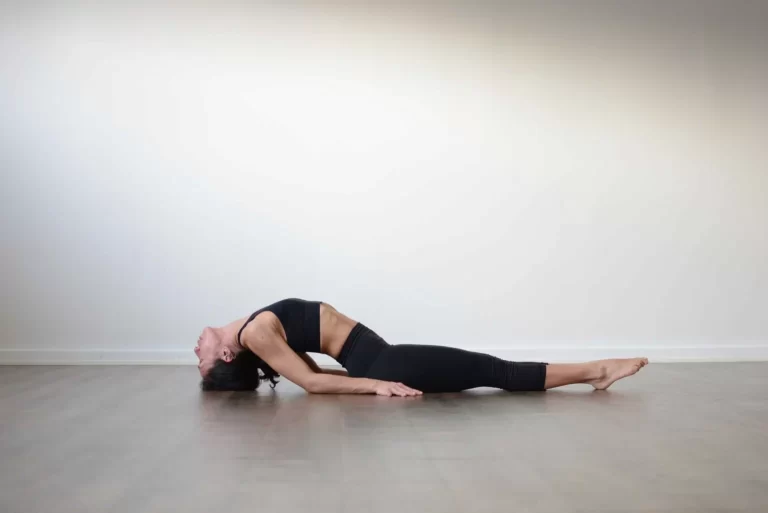13 Best Exercise for Squint Eyes (Strabismus)
Strabismus exercises aim to strengthen eye muscles, improve focus, and enhance coordination between both eyes. Techniques like pencil push-ups, Brock string, and eye patching can help improve alignment. Regular practice under professional guidance can support better visual function.
Introduction:
A condition called strabismus, or squinting, happens when both eyes are not correctly aligned. One eye may focus on an object while the other eye turns upward, downward, inward, or forth. This misalignment can happen continuously or occasionally affecting concentration and leading to difficulties including double vision, difficulty recognizing length, and even eye pain.
Even though vision therapy, surgery, or corrective lenses are frequently used to cure this condition, Exercise for Squint Eyes (Strabismus) may sometimes help with alignment, particularly in moderate cases.
Strengthening the eye muscles while improving the brain’s capacity to regulate eye movements are the usual goals of these exercises. To find the best workouts and treatment plan for your particular case in point of squint eyes, you must speak with an eye expert.
Causes:
The optimal course of treatment for strabismus depends on knowing the different disorders and variables that can cause it.
The primary causes of strabismus are as follows:
- An imbalance of muscles
An imbalance in the muscles that govern eye movement is frequently the cause of strabismus. The six muscles that regulate each eye enable it to move in various directions. The eye may not align correctly if one or more of these muscles is weaker or stronger than the others.
- Errors in Refraction
Blurred vision results from refractive errors, which happen when the eye’s shape makes it difficult for light to concentrate correctly on the retina. Strabismus may result from one eye being noticeably more able to see visually impaired, or astigmatic than the other.
- Amblyopia
A disorder known as amblyopia, or lazy eye, occurs when one eye’s vision becomes blurred and cannot be completely corrected with glasses or contact lenses. Strabismus, in which the brain fails to receive signals from the misaligned eye, is frequently the cause of amblyopia. This results in poor visual development in that eye.
- Factors related to genetics
Strabismus may run in families because it can be genetic. One is more likely to develop strabismus if a parent or sibling already has it.
Brain or Neurological Disorders Strabismus can result from nerve damage or neurological problems that affect the nerves controlling the eye muscles. These disorders can affect eye coordination and result in misaligned eyes.
- Injury or Trauma
Strabismus can be caused by physical harm to the eye or the muscles that surround it. A direct hit to the eye region, an accident, or surgery could cause this.
- Thyroid Eye Disease (TED)
The tissues surrounding the eyes are affected by thyroid eye disease, an autoimmune disorder that frequently results in inflammation and swelling of the eye muscles. Especially when the eyes are misaligned or protruding, this problem can lead to strabismus.
- Systemic Illnesses
Strabismus can be worsened by some systemic health disorders that affect how the eye muscles develop and function. Down syndrome, craniofacial deformities, and other genetic syndromes affecting the eyes and eyesight are examples of these conditions.
- Issues with Vision Caused by Convergence Lack
A condition known as convergence insufficiency happens when the eyes cannot cooperate to focus on close things, such as reading. When attempting to focus on anything nearby, this may cause one or both eyes to tilt outward.
- Environmental Aspects
Particularly in youngsters, strabismus can develop or worsen as a result of excessive screen time, extended near-vision jobs, or bad posture when reading or studying.
Signs and symptoms:
Squinting, also known as strabismus, is a condition in which one or both eyes turn inward, outward, upward, or downward due to improper eye alignment. Numerous physical and visual issues may result from this imbalance. Early detection of the condition’s symptoms is important for its management and avoiding consequences like double vision amblyopia, or lazy eye.
The following are typical strabismus symptoms and indicators:
- Eye misalignment
The most noticeable symptom of strabismus is the eyes’ obvious misalignment. Both eyes might not line up correctly, or one eye can seem to be looking in a different direction than the other.
- Double Vision (Diplopia)
Due to visual confusion caused by the brain receiving two separate pictures from the misaligned eyes, people with strabismus may experience double vision. When the eyes cannot adequately focus simultaneously, this can occur.
- Fatigue or Eye Strain
The eyes may have to work harder to focus or stay in alignment if they have strabismus. Particularly when engaging in activities that demand extended eye strain, like reading or screen time, this additional effort may result in eye strain or feeling exhausted.
- Challenges in Perceiving Depth (Binocular Vision)
The eyes cannot properly coordinate to perceive distance and depth when they are misaligned. Driving, participating in sports, and even going down stairs may become more challenging as a result.
- Head Turning or Tilting
Some people who have strabismus can sway or turn their heads in a specific direction to correct eye misalignment and improve their vision. This improves attention and lessens the effect of double vision.
- Shutting One Eye in Direct Light
Strabismus sufferers may squint or close one eye to lessen their pain from misalignment, particularly in bright light. This routine can also be used to block out one eye to control double vision.
- Frequently Reported Blurred Vision Issues
Blurred or unclear vision can result from strabismus, especially if the eyes cannot properly concentrate together. This can make it more difficult to see properly, particularly while doing tasks that call for close attention to detail.
- Headaches or Eye Pain
Frequent headaches or eye pain may result from strain on the eye muscles caused by strabismus. When the eyes are continuously trying to focus or align correctly, this might happen.
- Esotropia, or crossed eyes, in newborns or young children
In young children, strabismus may be more obvious, particularly in babies. One or both of an infant’s eyes may appear to turn inward toward the nose, giving them the appearance of crossed eyes. By six months of age, this condition usually goes away on its own, but if it continues, therapy is necessary.
- Narrowing or Squinting the Eyes
To make up for their poor eye alignment, people with strabismus frequently squint or narrow their eyes. This could happen unconsciously to improve focus or lessen double vision.
- Children’s Abnormal Visual Behavior
Young children’s conduct can reveal the presence of strabismus even though they may not always be able to articulate its symptoms verbally.
- Unable to Concentrate on Close or Far Objects
Since their eyes are not correctly aligned, people with strabismus may find it difficult to focus on objects that are too close or too far away. This can make it difficult to read, watch TV, or play sports.
Advantages of Exercises:
The treatment of strabismus (squinting) can benefit greatly from eye exercises, which are frequently a component of vision therapy. Even though they might not be effective in every situation, exercises have several advantages, especially for people with mild to severe strabismus. These exercises are helpful in the management of this problem since they may improve eye alignment, strength, and coordination.
The following are the main benefits of squint eye exercises:
- Better Eye Coordination
The eyes can be trained to move and focus at the same with exercises like the Brock string and convergence exercises, which will improve alignment and muscle coordination.
- Building Up Weak Eye Muscles
Frequent eye muscle strengthening exercises, such as pencil push-ups or concentration exercises, help improve alignment and control over eye movement.
- Decreased or eliminated diplopia, or double vision
The likelihood of seeing double can be decreased by exercises that encourage good eye alignment, such as utilizing the Brock string or focusing on a target.
- Improved Sensation of Depth
The brain’s capacity to integrate visual information from both eyes is improved by exercises that support binocular vision, or the cooperation of both eyes, resulting in improved depth perception.
- Preventing Lazy Eye, or Amblyopia
Amblyopia can be prevented or treated with regular eye workouts that strengthen the weaker eye and motivate the brain to use both eyes.
- Improved Eye Strain Reduction and Visual Comfort
Exercise for the eyes can help lessen headaches, ocular tiredness, and pain caused by overexertion and muscle imbalance.
- Improved Visual Focus and Attention
By strengthening the brain’s capacity for maintaining attention on objects, exercises that encourage visual tracking and focus improve visual processing in general.
- Improved Muscle and Eye Health
Frequent exercise can help maintain healthy eye muscles while improving their performance, which may stop further eye alignment degeneration.
- Self-Management and Empowerment
Exercise increases motivation and a person’s sense of control over their condition by providing them with the means to independently maintain their eye health.
Exercise for Squint Eyes (Strabismus):
The exercises listed below might help people with strabismus align their eyes better.
Pencil Push-Ups
One of the most popular strabismus exercises is this one. It promotes both eyes to focus together and helps to strengthen the eye muscles.
- Look for a pen, pencil, or any other small thing that has a sign or text on it.
- For your eyes to follow, the object should ideally have a distinct focus point.
- Maintain proper posture when sitting upright in a comfortable chair.
- Avoid slouching since this may affect your ability to complete the workout.
- Stretch your arm straight out in front of your face while holding the pencil or object at eye level in front of you.
- Both of your eyes should be able to view the pencil well.
- Try to concentrate on the pencil (or object).
- Make sure both eyes are focused on the same thing.
- Keep your attention on the bridge of your nose as you slowly move the pencil or object toward it.
- To stay focused, your eyes should converge, or shift inward toward one another, as you move the pencil closer.
- Continue slowly drawing inward with the pencil until you begin to see double or lose focus on the thing.
- At this point, your eyes are unable to cooperate with a single view. As soon as double vision or concentration problems arise, put the pencil back at arm’s length.
- Moving it slowly back and forth while keeping as much attention as you can is your aim.
- Slowly move the pencil toward and away from your nose as you do the exercise five to ten times.
- Every time you move the pencil, try to keep your attention on it.
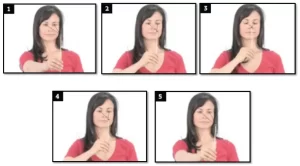
Eye-Tracking
For those with strabismus, eye movement synchrony is essential and this exercise helps with that.
- Choose a fixed object that is simple to see and concentrate on, such as a pencil or pen, or a small target like a ball or colored sticker.
- Use something that contrasts sharply with the background, if possible.
- Get into a comfortable standing or sitting position.
- Keep your head forward and your posture neutral.
- To prevent strain on the neck, keep the target at eye level.
- Hold the target in front of your eyes, 10 to 12 inches from your face.
- Focus both eyes on the subject and look at it.
- While keeping the target within your field of vision, move it carefully in the following directions: up, down, left, and right.
- Keep your pace constant while you move the target a few inches at a time.
- The goal is for the object to be easily followed by both eyes.
- Make sure both eyes are following the target continuously as you move it, avoiding eye separation.
- As the object moves, your eyes should follow it together, moving in the same direction and keeping your attention on it.
- Move the target slowly to the left and right at first, then progressively pick up the pace when you feel comfortable.
- Moving the thing smoothly without jerking your eyes is the goal.
- Track the target in one direction for a few seconds, then move it back to the center of your field of vision, right in front of you.
- Then, repeat the exercise in alternate directions.
- Focus on maintaining fluid and coordinated eye movements while you perform this exercise for two to three minutes each session.
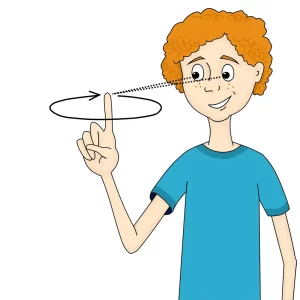
Constant Blinking
Exercises that involve blinking can help maintain eye moisture and lessen eye strain.
- Either stand in a neutral position or sit on a comfortable chair.
- Make sure your shoulders and neck are not strained and that you are at ease.
- Select an object, wall, or target in front of you to serve as your point of focus.
- If it’s more convenient, you can alternatively choose to concentrate on your image in the mirror.
- Start by slowly and carefully blinking both eyes.
- Every blink needs to be fluid and organic.
- Try to blink every three to five seconds.
- With each blink, gently close your eyes for one to two seconds.
- Keep your attention on the thing you’re looking at as you blink.
- This practice relaxes the muscles used for blinking while encouraging your eyes to stay in alignment and cooperate.
- Blink more quickly and frequently after a few minutes; try to blink two to three times per second.
- By doing this, tension will be lessened and the eye muscles will become more flexible.
- Without straining yourself, keep blinking for two to three minutes.
- Remain calm and concentrate on keeping a constant pace.
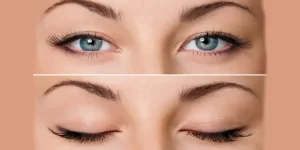
Palming
As it promotes muscle relaxation and reduces eye fatigue, palming is one of the most effective traditional workout methods.
- Maintain a straight back while sitting comfortably in a chair.
- Make sure you’re calm and in a place where you won’t be bothered.
- For 10 to 20 seconds, softly rub your palms together.
- This warms your hands, which could increase the exercise’s calming effects.
- Gently close your eyes.
- Next, cover your closed eyes with the palms of your hands.
- Your palms should completely enclose your eyes, obstructing all light, and your fingers should rest on your forehead.
- Make sure your hands are not putting pressure on your eyes; instead, place them lightly over them.
- Your hands should be raised so that they comfortably cover your eyes.
- Cover your eyes with your palms and concentrate on letting your whole body relax.
- Breathe slowly and deeply to help you relax even more.
- Imagine the tightness in your face and eyes diminishing as you breathe.
- Concentrate on the shadows behind your eyelids.
- Keep your thoughts clean and your body relaxed.
- For one to three minutes, keep your hands still and your eyes closed.
- Take slow breaths, let your eyes rest, and concentrate on the calming darkness throughout this time.
- After one to three minutes, carefully take your hands away from your eyes.
- To readjust your vision, slowly open your eyes and blink a few times.

The game of barrel cards
A barrel card must be held parallel to the nose for this exercise. The circles are positioned with the largest circle most distant and in perfect horizontal alignment.
- During this exercise, concentrate on the red circles with one eye and the green ones with the other.
- Now focus on the distant circles and adjust your vision such that the two circles merge into a single, equal red-green circle.
- Later, move this focus to the center and then the smallest circle using the same technique.
- Take a minute to unwind and let your eyes rest after completing a cycle.
- You should complete ten cycles of this exercise.
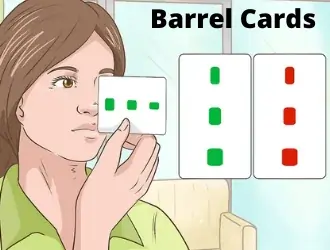
Exercise Dot-to-Dot
This exercise contributes to better control over eye movement and alignment.
- Sketch a random pattern of dots on a piece of paper.
- Focus on the first dot at first, then visually link the dots as you move on to the next one.
- Continue until all the dots on the paper are connected.
- This exercise contributes to better control over eye movement and alignment.

Focus Shifting
The ability of the eyes to shift focus from one object to another is improved by this exercise, which can be particularly beneficial in strabismus situations where focusing issues are present.
- Take out a pencil, pen, or any other little object that is comfortable to hold at arm’s length.
- If using your finger is more handy, you can do it as well.
- The object should be kept directly in front of you, 12 to 18 inches from your eyes, and at arm’s length.
- Make sure that both eyes are focused on the object for ten to fifteen seconds.
- After concentrating on the close object, gradually move your eyes to a far-off object (such as a point on the wall ten to twenty feet away or something outside a window).
- Spend ten to fifteen seconds concentrating on the faraway item.
- Return your attention to the item you were holding at arm’s length and hold it there for ten to fifteen more seconds.
- For a total of five repetitions, keep switching between the close and far objects.
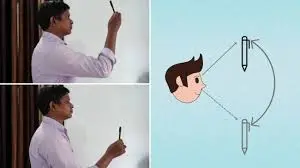
Focus on the Near and Far (Accommodative Facility)
Improving eye coordination and focusing power is a benefit of this exercise, particularly when switching between close and far objects.
- Locate two objects: one close by (such as a pen, your finger, or a little book) and one far away (10–20 feet), such as a tree, a building, or a picture on the wall.
- The near object should be held 6 to 8 inches away from your eyes.
- Spend ten to fifteen seconds concentrating on the object.
- Verify that both eyes are focused on it.
- Focus on the distant item, which should be between 10 and 20 feet away, without turning your head.
- Make sure both eyes are in alignment and concentrated for 10 to 15 seconds while you concentrate on the faraway item.
- Keep switching between the close and faraway things every ten to fifteen seconds.
- When switching, make an effort to maintain both eyes’ coordination and focus.
- Do the exercise for two to three minutes, switching between the close and faraway items five to ten times.
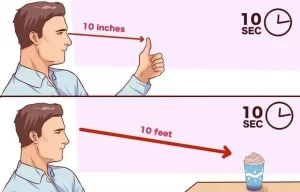
Brock String Exercise
This more complex exercise trains integration, or the eye’s capacity to focus on an object that is near.
- This is a string that is between 10 and 15 feet long and has several pearls scattered throughout it.
- One can be made by tying various colored pearls at different points along a thread, or it can be made using a piece of yarn and small, obvious items (such as knots, buttons, or pearls).
- Anyplace you can attach the string such that it extends horizontally, such as a flat wall.
- About three to five feet in front of you, fasten one end of the rope to a stationary item, such as a chair, door handle, or other strong object.
- Place the string’s opposite end against your nose tip.
- Now, stretch the material out in front of you, marking it with pearls or markers at regular intervals.
- The distance from the string’s attachment point should be between 10 and 15 feet.
- Start by concentrating on the pearl that is closest to your nose.
- You should see a single image of the bead when both eyes are focused.
- In each bead, look for the “X” design where the chain crosses.
- It will seem as though the string is divided into two lines, one for each eye. Try for the same bead with both eyes.
- Focus on the closest item first, then move your attention to the next piece a few feet distant along the string.
- Once more, concentrate on a single pearl and try to envision only one image.
- The tiny object should remain in the focus of both eyes.
- The string may now seem more clearly divided, but it’s still important to keep your attention on the pearl.
- One by one, slowly shift your attention to the next piece along the connecting line.
- Give each bead five to ten seconds of attention.
- Double vision, or seeing two beads of various sizes, indicates that your eyes are not aligned correctly.
- Try again with greater focus.
- Once you have worked your way along the rope, make sure both eyes are focused on the pearl nearest your nose before refocusing your attention there.
- Spend five to ten minutes on the exercise, paying five to ten seconds to each pearl.
- As you gain comfort, gradually raise the speed from a low starting point.

Window Gazing
Trains your eyes to better align and concentrate at close and far distances.
- Select a window that provides a clear view of both nearby and far-off things.
- It might be a window with buildings, trees, or any other type of scenery that combines features from close and far away.
- Start by concentrating on an object near the window.
- This might be anything within a few feet of you, such as a plant or decoration next to the window or a portion of the window frame.
- Make sure both eyes are focused on this object for ten to fifteen seconds.
- When focused, try to keep your eyes relaxed and not strain.
- Once the object in front of you has captured your attention, carefully move your eyes to something outside the window, like a building, tree, or far-off landscape.
- Make sure both eyes are lined up and sharply focused for ten to fifteen seconds as you concentrate on this far-off item.
- Return your attention to the close object you began with and hold it there for ten to fifteen more seconds.
- Keep switching between the close and far items, paying ten to fifteen seconds to each.
- Try to do this by switching concentration 5–10 times.
- After finishing the exercise, let your eyes relax by gently closing them for a short while.
Convergence Exercise
Improves convergence, which is the capacity of both eyes to concentrate on the same object.
- Choose a tiny object that you can hold in front of you with relaxation like a pen, pencil, finger, or anything else.
- As it offers an individual point of attention, pens are frequently utilized.
- Focus on the object while holding it at arm’s length and straight in front of your eyes.
- Make sure it is not too high or too low and that it is at eye level.
- Use both eyes to focus on the object.
- The object should appear as a single image.
- Your eyes need to be gently trained to focus together if you experience double vision, which indicates that they are not aligned correctly.
- Move the thing carefully toward the tip of your nose while maintaining eye contact.
- To maintain focus as you move the object closer, both eyes should converge, or turn inward toward the nose.
- Until you begin to experience double vision, or when the object appears as two pictures, continue to move it closer to your nose.
- At this time, the item can no longer be maintained in focus as a single image by your eyes.
- After you notice double vision, slowly move the thing away from your nose until the double vision goes away and the object is once again a single image.
- Ten to fifteen times, move the thing back and forth.
- To maintain the object’s alignment and clarity, concentrate on getting both eyes to cooperate.
- Make sure both eyes are converging without straining as you do the exercise for five to ten minutes.
- To relax your eyes, softly close them for 30 seconds after finishing the activity.
- To help release tension, you can also perform palming, which involves gently placing your hands over your closed eyelids and rubbing them together to create heat.
Making Eight
- Use your eye to slowly rotate the number eight.
- By doing this, you will stretch your muscles in every direction and increase the flexibility of your eyes.
- You can also repeat this exercise by making different A letters or numbers.
- Overall, this is a great and effective way to improve your focus and visual clarity.
Vision Therapy
- Vision therapy is an extensive program that is made up of a variety of exercises and activities to improve visual skills.
- It is typically performed with the help of an optometrist or vision therapist.
- By teaching the brain and eyes to work together properly, vision therapy helps treat squint eye and other underlying visual problems.
What precautions must be considered when working out?
To prevent pain, strain, or even eye damage, safety should always come first when doing eye exercises for strabismus.
Here are some essential safety precautions to take:
- First, speak with an eye specialist.
It’s important to speak with an eye specialist (ophthalmologist or optometrist) before starting any eye exercises. They can assess how severe your strabismus is and advise you on the best workouts for your issue. They also help you in developing reasonable goals for benefits and advancement.
- Don’t Overdo It
Avoid doing too many exercises. As you become more comfortable, progressively extend the length of your sessions from short ones of five to ten minutes. Eye strain or pain may result from prolonged or too severe exercise.
- Pay Attention to Your Body
Exercise should be stopped right once if you feel any pain, extreme difficulty, headache, or dizziness. Double vision or ongoing pain are indicators that the workouts may not be suitable for your condition or that they should be modified. For more advice in this situation, speak with your eye care professional.
- Use the Correct Method
Always follow your eye specialist’s advice when performing workouts. It’s essential to use the proper strategy to prevent overstressing your eyes. Incorrect movement or posture may worsen the illness or cause new eyesight issues.
- Take pauses in between workouts.
Take a few moments between exercises if you are doing more than one so that your eyes can rest. This lowers the possibility of eye strain and keeps concentration and coordination high during each workout.
- Practice in an Area with Good Lighting
Make sure the space where you are doing your eye exercises is comfortable and well-lit. The effectiveness of the workouts may be affected by poor lighting, which might strain your eyes and make it difficult to concentrate on the things you’re utilizing.
- Make Use of the Right Equipment
Use an obvious, visible object, such as a pencil or a marked card, for exercises like pencil push-ups or tracking. Stay away from using anything that might be difficult to focus on or that could strain your eyes, such as tiny or extremely complicated objects.
- Avoid Eye Fatigue
Take rests before performing eye exercises if you’ve been using your eyes for long periods (such as reading, using a computer, etc.). You might not be able to focus properly and your eyes could not react well to exercises if you are tired, which could cause strain or pain.
- Minimize Distractions
To complete the exercises, pick a place that is peaceful and free from distractions. This guarantees that you may concentrate entirely on the exercises and stops unnecessary eye movements caused by distractions from outside.
- Be patient while remaining constant.
Consistent practice over time is necessary for eye exercises, but effects may not be seen for weeks or months. Do not expect results immediately or speed up the procedure. Follow the recommended routine if the workouts are beneficial, but take it slow and easy on yourself.
- Track Development and Report Modifications
Evaluate the exercises’ success regularly. Inform your doctor of any changes you observe in your vision, such as increasing double vision or growing trouble focusing. They might need to think about alternative approaches or modify their treatment plan.
When should you stop practicing exercise?
If any of the following conditions or symptoms appear, it’s important to stop strabismus eye exercises. When these problems arise, continuing to exercise could worsen the situation or result in more complications.
The following are some indicative indicators that you should stop doing eye exercises:
- Increased or Chronic Pain
It’s important to stop the workouts if your eye pain continues or becomes worse. When you initially start, little pain may be typical, but if the pain continues or becomes acute, it may indicate that you are overexerting your eyes or that the exercises are not suitable for your condition.
- Severe double vision
As you train your eyes to focus together, some moderate double vision may happen. However, if double vision gets worse or lasts longer during exercises, it’s a sign that your eyes aren’t cooperating correctly. Stop and speak with your eye doctor to modify your treatment plan if this happens.
- Feeling lightheaded or unwell
Stop doing eye exercises right once if you start to feel lightheaded or nauseous. This may indicate visual strain or confusion as a result of your brain’s inability to fully process the visual information from both eyes. These signs may suggest that the exercises are too strenuous or unsuitable for your health.
- A headache
A warning sign is frequent or severe headaches during or after eye exercises. Headaches might result from eye strain caused by performing workouts too fast or for an extended period. If this happens, shorten the duration or intensity of your sessions and make sure you are performing the exercises properly by speaking with your eye care professional.
- Increased Eye Fatigue or Strain
Your eyes should be stopped if they are constantly fatigued, strained, or overworked. Putting too much effort on your eye muscles without getting enough sleep could worsen the issue. To prevent tiredness, make sure you take enough breaks during your workouts.
- No Change Following Regular Practice
It could be time to review your treatment plan if, after weeks or months of regular practice, you still don’t see any change in alignment, coordination, or symptom relief from your eye exercises. To find out if you need surgery, corrective lenses, vision therapy, or another treatment, speak with your eye doctor.
- New or Increased Visual Issues
If you have new visual problems like blurriness, light sensitivity, or trouble focusing on things, stop the exercises and get evaluated by a professional. These can indicate that a different strategy is required or that your condition is not improving with the activities.
- Redness, irritation, or swelling of the eyes
Take a break and keep an eye out for any more signs if your eyes get swollen, red, or itchy during or after exercising. These could point to an underlying problem that needs medical care, like an eye infection, allergies, or other ailments.
- Medical Advice to Stop
For this reason, you should heed your eye care provider’s advice and stop performing the activities. They might conclude that the exercises aren’t suitable for your particular illness or that a different kind of treatment is needed.
- Pain on an emotional or psychological level
Eye workouts can occasionally be frustrating, particularly if you feel that your progress is slow or challenging. It may be beneficial to take a break if you are feeling anxious or distressed while completing the exercises. Any worries can be avoided by discussing your experience with your healthcare professional.
Additional Advice for Managing Strabismus:
- Wearing Corrective Lenses: It’s important for people with optical problems that cause strabismus to use suitable glasses or contact lenses. Verify that your prescription is current.
- Vision Therapy: Under the guidance of an optometrist, vision therapy can help correct strabismus while improving eye coordination in addition to exercises.
- Surgical Options: To realign the eye muscles or correct muscle imbalances, surgery can be required in severe cases.
- Use of Patches: Applying a patch to the stronger eye can sometimes strengthen the weaker eye while improving alignment.
When to Consult an Ophthalmologist:
It’s important to contact an eye specialist if the squint is ongoing or substantially affects your vision or ability to carry out routine tasks. The kind and severity of the strabismus will determine the available treatment options. Additional treatments, such as glasses, vision therapy, or even surgery, could be suggested if eye exercises prove ineffective.
Summary:
Exercise and other therapies can help restore eye alignment and function, even though strabismus can be a difficult condition. The eye muscles can be strengthened and good eye coordination can be promoted with regular practice of eye exercises including pencil push-ups, eye tracking, and focus shifting. To be sure the exercises are suitable and beneficial for your particular condition, it is important to speak with a healthcare provider.
Beyond only improving vision, regular practice offers advantages including increased focus, less eye strain, and possibly even protection against amblyopia. Adopt these workouts for a better future and a clearer, healthier vision.
To improve the alignment and coordination of the eyes in strabismus, keep in mind that early intervention and regular practice are essential. Many people can see significant improvements in their quality of life and vision with the correct approach.
FAQ:
Is it possible to correct squinty eyes using eye exercises?
In fact, in mild cases of strabismus, eye exercises may help improve eye alignment. They can help focus better, strengthen the muscles in the eyes, and increase eye-eye coordination. However, people with mild or intermittent squinting seem to benefit more from activities. Surgery, glasses, or vision rehabilitation can be required in more extreme situations.
How much time should I spend performing eye exercises for squints?
Eye exercises should be performed every day for ten to fifteen minutes at a time for optimal effects. Before you notice significant benefits, you might need to perform these exercises for a few weeks or months, depending on the severity of your problem and the recommendations of your healthcare professional. The secret is regularity.
Do adults with strabismus benefit from these exercises?
Yes, eye exercises may help adults with minor strabismus, although treating adults with this condition might be more difficult than treating children. Optometrists frequently advise individuals to undergo vision therapy, which may include eye exercises, to improve eye alignment and coordination.
If I feel pain or experience blurred vision, should I stop practicing eye exercises?
When doing eye exercises, it’s important to pause and speak with your healthcare physician if you feel uncomfortable, have double vision, or have any other strange symptoms. Although some pain is common when beginning an exercise program, ongoing symptoms could mean that further treatment is required or that the activities aren’t helping your problem.
Can strabismus be treated with eye exercises instead of surgery?
Surgery is unlikely to be replaced by eye exercises alone, particularly in situations of severe strabismus. When the eye muscles need to be moved or adjusted for enough alignment, surgery is frequently advised. However, because they improve eye coordination and help sustain the effects of surgery, exercises can be used in conjunction with surgery or other treatments.
Are eye exercises for strabismus beneficial for kids?
Yes, eye exercises can be quite beneficial for kids with strabismus, especially if they begin early. By training the eyes to cooperate, regular practice can improve vision and avoid long-term issues. To guarantee that activities are performed correctly, parents need to work with an eye specialist.
Do strabismus eye exercises have any side effects?
In general, there are no serious side effects, and eye exercises for strabismus are safe. However, eye strain or temporary pain could result from overdoing it or using the wrong technique. To prevent such problems, always do as your eye doctor or optometrist instructs.
Can I combine eye exercises with other strabismus treatments?
Yes, eye exercises can be done in conjunction with other strabismus therapies including vision therapy, patching one eye to strengthen the weaker eye, or wearing corrective glasses. The best way to manage strabismus is frequently to combine several different treatment methods.
How can I determine whether eye exercises are effective?
After a few weeks of regular practice, you should begin to see changes in your eye alignment and coordination. Reduced double vision, increased focus, improved understanding of depth, or more continuous eye coordination are all indicators that the exercises are having an effect. See your eye care specialist for another assessment if, after a few months, you still don’t see any improvement.
If squinting is not treated, might it lead to vision issues?
Untreated strabismus can result in visual issues like amblyopia, also known as lazy eye, in which the brain chooses one eye over the other, impairing vision in the weaker eye. Additionally, it may result in double vision, eye strain, or weakness, as well as affect your sense of depth. These issues can be avoided with early action.
Is it possible to treat squinting without surgery?
It is possible to treat a lot of strabismus cases without surgery, particularly if the disease is identified early. Corrective lenses, eye exercises, vision therapy, and patching are among the available treatment methods. In situations that are more severe or unresponsive, surgery is typically recommended.
After I get well, how can I keep up with the effects of my eye exercises?
To make sure the alignment remains perfect after improvement is observed, it’s important to keep up with management exercises or follow-up appointments with an eye care professional. Periodic workouts may be advised in some situations to maintain the strength of the eye muscles and stop degeneration.
Does squinting result in headaches or other symptoms?
Headaches, eye strain, and pain can result from strabismus, particularly if the eyes are straining more to correct the misalignment. Additionally, this may result in exhaustion and trouble focusing. These symptoms can be lessened with the use of workouts, corrective lenses, or other therapy.
References:
- Sankhla, D. October 6, 2023. 16 Strabismus exercises that work best for squint eyes. Samarpan Clinic for Physiotherapy. You may get the greatest squint-eyes-strabismus exercise at https://samarpanphysioclinic.com/16.
- Wylee, Oscar (n.d.). Four strabismus eye exercises. Glasses/eye/strabismus-and-eye-exercises https://www.oscarwylee.com.au
- How might workouts for squint eyes aid in vision improvement? March 12, 2024. The Sight Avenue. https://thesightavenue.com/blog/squint-eye-exercise
- Admin. December 5, 2024. There are eleven simple exercises for squinting eyes that you can do at home. Bynocs. Squint-eye exercises: https://www.bynocs.com/
- Goel, S., and Goel, S. (November 6, 2023). 3. To expedite squint treatment, squint doctors prescribe squint eye exercises. Arohi Eye Hospital. https://www.arohieye.in/3-best-exercises-by-squint-specialists-to-speed-up-squint-treatment/
- Fitness Trinetra. February 1, 2022. Exercises for Natural Squint Eye Correction at Home [Video]. YouTube. YouTube video: https://www.youtube.com/watch?v=uZAlPSUFxso
- K, Y. (2025, January 17). Best squint eye Exercises: Effective approaches for squint correction. Nethradhama. https://nethradhama.org/blog/squint-eye-exercises/
- Image 1, Health has been restored. September 7, 2018. Restoring health with pencil push-ups. Push-ups with pencils: https://healthrestored.com/
- Image 2, On February 24, 2020, Forrest, S., and Forrest, S. Eye-tracking: assisting kids with reading. The best method for teaching struggling readers is to assist them in reading. Eye-tracking causes: https://helpingchildrentoread.com/
- Image 3, Online yoga classes: Do Yoga (n.d.). https://do.yoga/blog/yoga-practices/blinking-exercise-:-practice-and-its-benefits-107
- Image 4, From Shah, E. Y. C. E. Y. E. S. (September 21, 2018). Palming: Take some time to rest your eyes. “Give your eyes a break, palming” https://www.linkedin.com/pulse/siddhi-shah.
- Image 5, Felsted, D., DO. October 8, 2024. Nine Steps to Correct Exotropia (with Pictures) https://www.wikihow.com/Fix-Exotropia – wikiHow.
- Image 6, Dot card: Convergence Insufficiency Orthoptic Exercises (n.d.). Cambridge University Hospitals. The following is a list of dot-card orthoptic exercises for convergence insufficiency: https://www.cuh.nhs.uk/patient-information/
- Image 7, Khuba, A. May 8, 2024. EYE STRAIN REDUCTIVE EXERCISES. Eye exercises to minimize eye strain/eye-hospital/general-ophthalmology/eye-tests-general-ophthalmology/ Vijaya Nethralaya. https://vijayanethralaya.com/
- Image 8 S, S. March 18, 2024. Unbelievably, double vision might cause further problems. https://specscart.co.uk/blog/double-vision Specscart
- Image 9, Vision therapy optometrist: https://www.visualsymptomstreatmentcenter.com/eye-care-services/brock-string-exercise/

